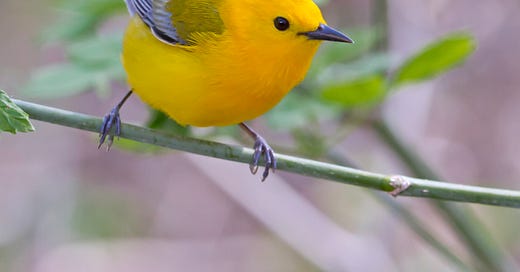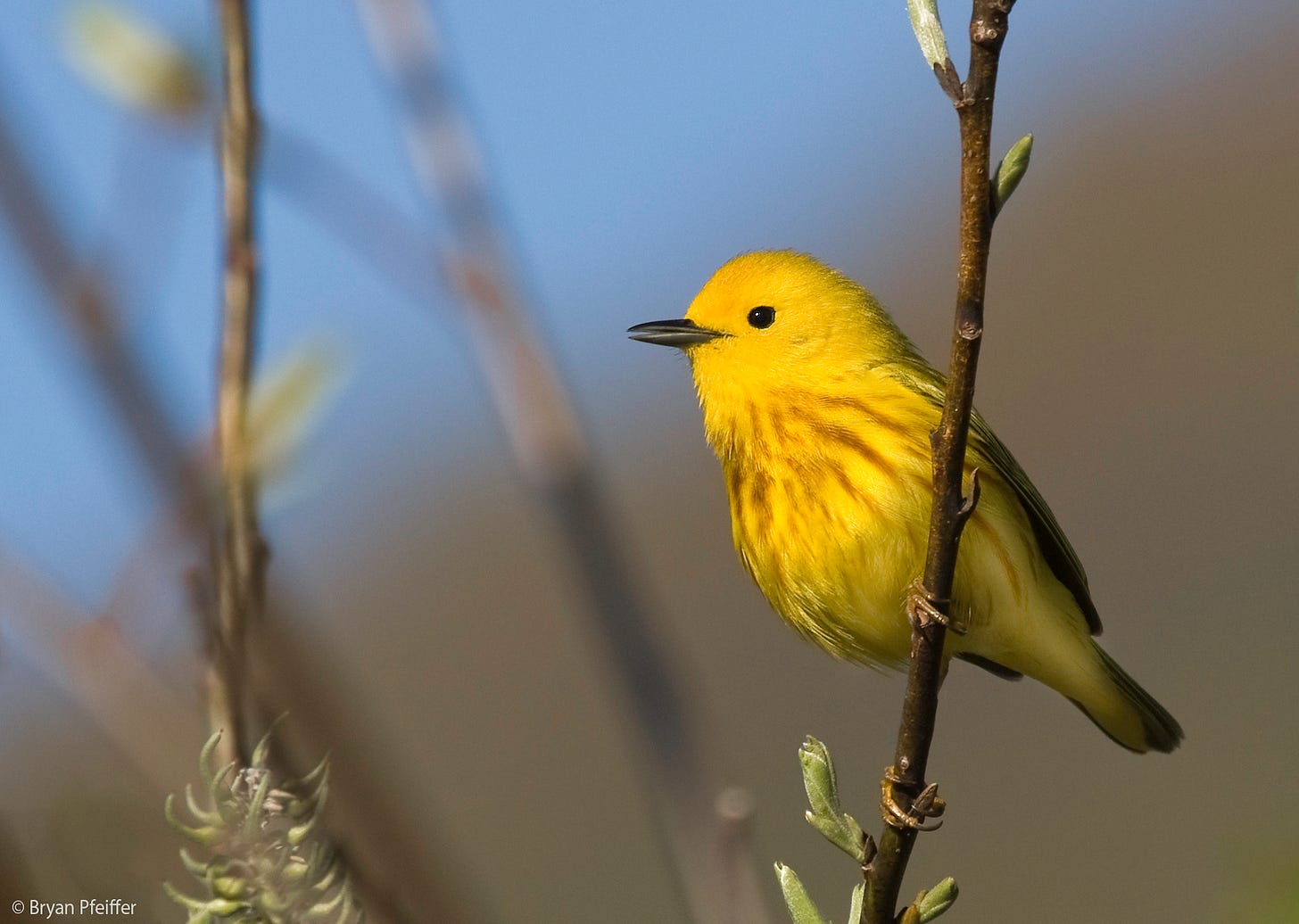Color, music, flight, and grace mingle in the lives of birds. But few pull it off like warblers. What’s a warbler? The standard definition is: a small, vocal, colorful, migratory bird in the family Parulidae. But this is an injustice to warblers. So here’s my definition:
war•bler | ˈwôrb(ə)lər |
noun
(1) A force of nature, like gravity or chocolate or lovemaking, like harmony or a sunset or a shooting star. (2) An honest declaration of trust; once you’ve experienced a warbler, it becomes your faith. (3) A bird to embrace before you leave this earth.
Across North America, we’ve got warblers marked like zebras, warblers with hoods, warblers with caps, warblers with bibs, warblers wearing raccoon masks, and a warbler, the Kirtland’s Warbler, which is among the rarest nesting songbirds on the continent. We’ve got warblers clad in crimson, flame, rust, chestnut, lemon, lime, jade, cerulean, and cobalt.
It gets even better when you add voice. We’ve got warblers that trill, warblers that shout, warblers that buzz, warblers that blurt, warblers that warble, warblers that rub together only a couple of notes, and warblers whose songs are so high and thin to be nearly inaudible to the human ear.
How big are warblers in the psyches of North American birdwatchers? A birder might find 100 or more species of all kinds during a busy dawn outing this time of year, but another measure of “success” is the warbler tally. Contemptible as it may seem to keep a running count of such grace, 20 or more warbler species in a morning is respectable. I’ve had a few 30-plus warbler days. And once, during a dawn rain shower on the shores of Lake Erie in northwestern Ohio, which produced a fallout of migrating songbirds, I encountered 20 warbler species in my first 20 minutes of birding, which may be my greatest feat of “listing” in nearly half a century of chasing birds.
Yet sadly, because songbirds are vanishing from this world, these full and fulfilling days among warblers are increasingly rare. And here I could cite for you study after study documenting heartbreaking declines in birds around the world. But you need no studies from me; instead, ask any of us who’ve been watching birds for 30 or 40 or 50 years or more. For us, it’s like watching extinction happen: fewer birds, muted color, absence of song — a world of diminishing beauty and meaning. To be sure, springtime is a season of joy — and now as well a reminder of profound loss.
Like no other group of observers in nature, birdwatchers like to count. For more than a century, we’ve made our lists and kept our tallies; we’ve rejoiced in our quantity of quality. But year after year, our songbird counts decline, the diversity withers. And should you doubt any of this, I dare you to find a soul among us who is not aware of and wistful about such loss. We are a death-watch that should not exist. We’re counting what we’re losing.
Still, Chasing Nature, this gathering place for us away from actual nature, is nothing if not present and aware and attentive. Week after week, despite so much pain in nature, here we find our way together toward wildlife and wild places. I like to think that each essay of mine is a kind of compass needle pointing at true nature, and toward genuine human nature.
We have work to do and birds to see. So even as we vote into oblivion politicians with rotten and selfish ideas, even as we press for conservation and human justice, and even as we mourn their losses, warblers and billions of other birds are now migrating north (or south in the Southern Hemisphere). Here in the U.S. and Canada, we’re approaching “peak warbler” this coming week. (Granted, in Europe my readers see a different collection of warblers, which are not nearly as ornate — not even close. But, c’mon, you’ve got White Storks, Northern Lapwings, European Bee-Eaters, and Bluethroats!)
On both continents, the birds are migrating through most any habitat, even our cities or your own backyard. And if warblers are new to you, in a postscript below I’ll do my best to guide you to the most cosmopolitan and accessible warbler in all of North America — a burst of energy and orange lightning with a beady black eye called Yellow Warbler.
After all, having now written 800 words of tribute to them, in truth all I might have written instead — and trust me on this — could have been these eight words: Warblers are good for you. Please find some.
Postscript
To find a Yellow Warbler, get thee to a shrubby wetland. Well, you’ll also find them along streams and rivers and shorelines of lakes and ponds. But shrubby marshes are great because Yellow Warblers sing and flash and nest at eye-level among willows and alders and other shrubs and trees that don’t grow too tall in wet places. It makes for easy viewing. Listen for a perky song resembling “sweet sweet sweet — I’m so sweet!” or “sweet sweet sweet — summer summer sweet!” Look. Melt. Repeat.
To help guide you, here’s an iNaturalist map of Yellow Warbler sightings across North America during the month of May. Zoom in (a lot), click on any point, and then click again for a photo and site details. Feel free to report your experiences in comments below. Thanks!









Bryan, this entire post is brilliant . Just reading your own definition of warbler, hits me straight into my bird heart, where everything I love about birds is wrapped in its own little nest. I listened to the same trio of warblers today, camouflaged in the new leaves , switching positions to either side of the trail , enhancing their songs. As if the trees themselves were singing . I will add the Black-throated Blue Warbler and Pine Warbler. “We are a death-watch that should not exist. We’re counting what we’re losing.” Like listening to Claude Debussy’s Clair de lune, sometimes so beautiful it hurts .There might be a bit of melancholy, mixed with a light heart, next time I tune in.
“Warblers are good for you. Please find some”. May the coming week be filled with magical warbling notes. I think I will turn away from the news during this week to fully celebrate the Warblers and friends. After all, what’s the worst thing that could happen in a week 😳🙈🙉🧨.
So good. I mean you can take virtually any piece of the nature puzzle and turn it into a holograph for the whole universe.